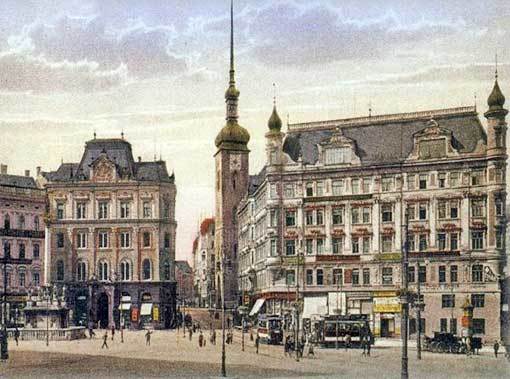The holiday series of Leoš Janáček’s texts Něco o hudbě brněnské (Something about music in Brno) will be concluded by his confession to the city where he spent the majority of his life. It is the year 1866 and Brno is occupied by the Prussian army...
It was in 1866.
It was quite a walk from Sv. Anna, the hospital on Pekařská street, to the king’s cloister1. Cholera was on a rampage, funerals were aplenty and we songbirds were at them.
The Cloister square was crowded with the Prussians. It was like black swarms descending.
And just yesterday there were “our” soldiers. They were fleeing.
The millrace from the cloister gate – Vincenc Brandl2 was living in the adjoining building at that time – flowed lazily and dirty and it went under a bridge.
From Pekařská street we could cross the bridge to Křížová street.
A cross next to the bridge.
Carriages were frantically speeding away and in a sudden dogleg one carriage overturned. Sacks went flying and coffee spilled from the torn ones. The narrow passage was blocked.
I was a witness of that turmoil.
Opposite Sv. Anna there was a small house. In its first floor there was a single window; in the ground floor there were stairs to the shop of our cobbler.
“I should repair this? Counters are off, the tops are like wings, and they had nothing to hold to!”
Behind the hospital there was a school at “Lakerwiese ”3 and behind it there was a leatherworker’s shop that stunk of leather.
Up to here we knew our way in the city. Anywhere further we would become lost.
When I was a boy a bit more grown, I went to violin and piano “lessons” to Hutter’s pond4
Pond? It was a bog and rubbish dump and along it there was a long chestnut tree-lined avenue. And the virtuoso Vilemína Normanová-Nerudová, my teacher, lived behind it in a solitary house.
And for me there were no orchards of Lužánky.
And to Černá Pole? The poor working class lived there.
At that time the city was not so large.
At the edge there was the municipal cemetery5 and St. Wenceslaus cemetery, “old” 6; even the church of Zábrdovice and the hospital of Milosrdní bratři (Merciful Brothers).
The St. Elizabeth sisters7 were already in seclusion.
To Pisárky and Žlutý kopec was almost a destination for trips.
A man could walk across the entire city.
Across it, from the “long” bridge, across Svratka to Vídeňka it extended, through Ypsilanti court, they called that the house, on whose gate a Turk with crossed legs was carved in stone,
along the leatherworker shop upwards to the serpent well under Františkov8,
into the gloomy and dark room like a cellar in number 7 on Starobrněnská street I went day after day, when I was visiting the organ school.
Run and run around, but to fall in love with the city of that time?
And suddenly I saw a city caught in a miraculous transformation.
The discord with the gloomy city hall and the hate towards the hill, inside of which used to be the screaming of so much pain9 vanished inside of me,
the disgust with the street and with the things swarming in it disappeared.
The light of freedom above the city was conjured, the rebirth on 28 October 1918!
I saw myself in it, I belonged to it.
And the boom of triumphant trumpets,
the holy calm of the king‘s cloister in Úvoz,
night shadows and the breath of a green mountain
and the sight of actual growth and the greatness of the city was born in my sinfonietta from this revelation,
from my city Brno!
Leoš Janáček, Lidové noviny, 24 December 1927
1 Augustian cloister at Mendel Square
2 Moravian historian
3 Leitner Street
4 Vrchlického sad (Vrchlického orchard)
5 on the current Antonínská and Smetanova streets
6 by the church of St. Leopold (“Milosrdných bratří ” – Merciful Brothers)
7 cloister in Kamenná street
8 Denisovy sady (Denis orchards)
9 he meant Špilberk Castle































